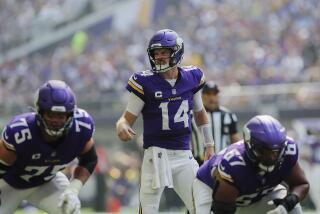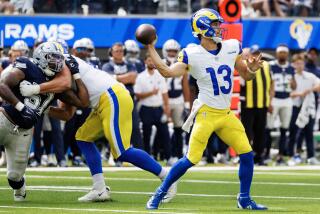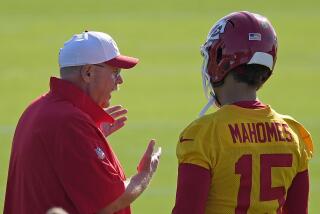Game of Emotion
At Indianapolis next Sunday, in the AFC night game of the year, the Oakland Raiders aren’t likely to be bothered by the same thing that troubled them against Dallas last Sunday, when they couldn’t take an 0-4 team seriously. They weren’t up for the Cowboys. Who could have been? This year, who will be?
Football is a game of mind, muscle and emotion--this is the only team game that’s all that--and when you’re emotionally unready for weak opponents, it isn’t easy to win, no matter how bright or talented you are, no matter if you’re twice the team they are.
As Raider quarterback Rich Gannon played his usual steady game, dividing 14 passes between wide receivers Tim Brown and Jerry Rice, the Raiders did manage to hold on, 28-21. They showed just enough for that. But it was reminiscent of the days when, after every inferior NFL performance, an embarrassed coach used to say, with much accuracy, “They were up and we were down.” The Raiders couldn’t keep Dallas scoreless because they knew the Cowboys were too feeble to win. It’s painful what has happened to the Cowboys in the 21st century, but that’s another story. This week’s story is that the Raiders better be up for two Indianapolis Colts in particular, Peyton Manning and Edgerrin James.
For Once, Cowboys Keep Scoring
THE RAIDER DEFENSE was breached Sunday by the kinds of scoring plays that an unemotional, superior football team should expect but often doesn’t. Thus, for one touchdown, a young Dallas quarterback, Anthony Wright, came off the bench to heave the ball down half the field into the end zone, where Dallas’ best player, wide receiver Joey Galloway, ran under it and held the ball. For another touchdown, the Raider special-team people were victimized by a fake field goal. For another, after a turnover and an interference penalty placed the ball at the Raiders’ nine-yard line, they were too slow and too logy to cover a three-yard touchdown pass.
Nothing in that surge suggested the Cowboys have turned a corner and will set out now to tear up the league. To the contrary, they will continue to contend with the Washington Redskins for worst in pro football. But now, perhaps, their owner, Jerry Jones, will at least cease selecting their starting quarterbacks. As running back Emmitt Smith, displeasing Jones, has said all along, third-year quarterback Wright is a much more productive leader for at least this season than Jones’ handpicked rookie, Quincy Carter. In the land of the Cowboys, it has to be depressing to realize that if Jones still had his old coach, Jimmy Johnson, they’d still be a Super Bowl contender. As a pair, general manager Jones and head coach-chief scout Johnson were all but unbeatable. As a single, Jones is a disaster.
Vikings Insure Double-Coverage
THE MINNESOTA VIKINGS, as they start the second month of their season Sunday against Detroit, will have to get more production from their best players if they are to regain their old place as a division contender with Green Bay and Tampa Bay. That seems clear now after their failure in the Superdome, where they lost a 28-15 game to a New Orleans team that didn’t look that good. Essentially, the Vikings beat themselves by constantly lining up two wide receivers and two tight ends to enhance a ground game they’ve lost anyway since running back Robert Smith retired. Incredibly, the Vikings tried to run with a plowhorse, rookie Michael Bennett, instead of throwing to a racehorse, Randy Moss.
Standing 6 feet 4, Moss is the tallest and fastest good wide receiver of all time. The Viking under center, Daunte Culpepper--also 6-4 and an acceptably accurate passer--is at 260 pounds the biggest good quarterback of all time. Combine Culpepper and Moss with a canny veteran receiver, Cris Carter, and you have the nucleus of a championship offense when properly deployed. Instead, the Vikings insist on simultaneously lining up two tight ends, insuring that Moss and Carter will each be double-covered by any NFL team deploying a standard four defensive backs, including New Orleans. To free Moss in the secondary, what the Vikings need most is obviously an offense with three wide receivers and sometimes four to challenge the defense. Obviously. Yet they don’t see that.
How Could Carter Do That?
THE TURNING POINT play in New Orleans was made by Viking receiver Carter, who, sprinting for what should have been a 55-yard second-quarter touchdown, allowed the ball to be stripped from his grasp an instant before he was to score. When the Saints recovered for a touchback, Culpepper, who had caught them off guard with a long first-down pass, sat down and asked himself how a 15-year NFL veteran like Carter could have blown such a play. At the moment, Culpepper was, perhaps, too much of a gentleman to put that question to Carter himself. As NFL crowds all know, rookie receivers are often stripped when in the exhilaration of reaching for the end zone on long pass plays they are too engrossed in themselves to protect the ball, but it was astonishing to see Carter so trapped.
In any case, Minnesota Coach Dennis Green, like 30 of the 31 other NFL coaches, soon went back to running the ball. Having proved that they could throw, the Vikings set out to prove that they could run too. And when the day was over, they were able to point, if not proudly, to a rushing total of 34 yards.
The NFL’s one passing coach is, of course, the Rams’ Mike Martz--who also, unlike Dennis Green, long ago protected himself at running back. After first trading for Marshall Faulk with Indianapolis, which couldn’t see what it had, Martz drafted a Faulk lookalike, Trung Canidate. Though Martz is the NFL’s lone believer in the power of the pass, particularly on first down, he also understands that a ground threat is indispensable.
30 Coaches Trying Not to Lose
THE DISTANCE BETWEEN the Rams and the NFL’s 30 other teams is being shown every week this year. The goal of every other head coach--even Denver’s Mike Shanahan--is, clearly, not to win but not to lose. In this league, there are 30 coaches who each week start out--and generally finish up--not trying to win but hoping to wait for the other team to make the killing mistake. As Shanahan said, explaining Denver’s 20-6 win over Kansas City Sunday, “We established the running game and prevented the turnover.”
That represents a major change in attitude from the days when Shanahan, as San Francisco’s offensive coordinator, was calling a record six Super Bowl touchdown passes for Steve Young. It’s even a change from the early days in Denver when Shanahan won two Super Bowls with, alternately, John Elway’s passes and the threat of Elway’s passes. But conservatism has come in time to every NFL passing coach--to Brian Billick, for example; to Norv Turner, to Shanahan, to everyone but the 1980s Bill Walsh and, now, Martz.
As the plainest result of all this, the electricity has gone out of most NFL games. When one coach after another sets out to establish the running game, there’s not much to see. Thus against Kansas City, Shanahan sent running back Mike Anderson boring boringly into the line on run after run. It’s true that Anderson won the game with one 62-yard touchdown--and it’s also true that a long touchdown run from scrimmage is probably the most stirring play in football. But for the spectator, there’s nothing much to see while you wait for such a play. In the Kansas City game, even though Anderson did go 62 yards in one bolt, he totaled well under 100 yards in 21 other largely ineffectual carries.
The great pass offensives Shanahan coached at San Francisco and early on at Denver provided more to see as well as a more certain way to win. But they also provided more risk; and football coaches, as they age, increasingly grow to hate risk.
Minus McCaffrey, Broncs Not Same
THE DENVER TEAM doesn’t look the same and indeed isn’t the same since Shanahan lost wide receiver Ed McCaffrey to a broken leg. A big man like Minnesota’s Moss, McCaffrey was the Broncos’ best and most valuable player, as everyone understands now. They still have Rod Smith, who is surely among the NFL’s finest four or five wide receivers; but when they had McCaffrey, too, they had two of the top four or five. In one offense.
When in a jam, Denver passer Brian Griese always looked first for McCaffrey; and unless surrounded by two or three defensive backs and linebackers, he was easier to find than mere 6-footers like Rod Smith. Actually, McCaffrey rises nearly an inch above Moss, and, unlike some NFL stars, he gave every play an all-out try. The question is whether, at 34 next season, he will ever come back to where he was when he went down.
The crippling McCaffrey injury, which resulted from a defensive player’s high-speed all-out hit, is a reminder of the fragility of football by comparison with, say, baseball and basketball--in which you can always get injured, but in which you’re not nearly so vulnerable. The rare beauty of the Ram offense, for example, is capable of being marred--of being destroyed, really--in any moment in which the Rams are on any playing field with their two great offensive players, quarterback Kurt Warner and running back Marshall Faulk. In fact, the Rams were in line to win their second successive Super Bowl last season had Warner escaped injury for all five of the games he missed. If in their fragile world the Rams can keep him upright from now until February, they’ll win it again, beating Baltimore if need be.
Great Passer, Two Weaknesses
ONE OTHER THING about quarterbacks: The new man in Kansas City, Trent Green, who was Warner’s replacement at St. Louis last season when he played effectively, has two weaknesses that most of us didn’t see a year ago, though Martz must have known it before dealing him off. In the heat of a tough game, it appears now, Green, a superb passer, is a little slow reading defenses. Second, with defensive players rushing at him, he’s a little slow moving about. Those are two Warner strengths. A fast reader, Warner, though not a wonderful scrambler, is a mobile mover when a pass play breaks down. Few assets are more important to an NFL quarterback.
Scouts and others keep telling us that Indianapolis’ man Peyton Manning leads the world in quarterbacking. A new NFL poll, ostensibly reviewing the opinions of most coaching staffs, lists Manning as the one quarterback the majority would take if starting a new team from scratch. And maybe so. Everyone, including me, loves Peyton as an athlete, but as a quarterback I’ll take Warner.
More to Read
Go beyond the scoreboard
Get the latest on L.A.'s teams in the daily Sports Report newsletter.
You may occasionally receive promotional content from the Los Angeles Times.










